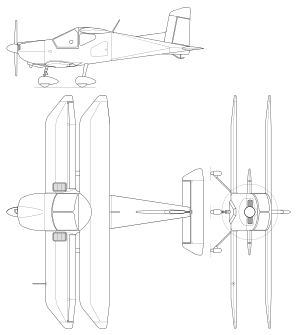Ganzavia GAK-22 Dino
The Ganzavia GAK-22 Dino was an unusual light utility aircraft built in Hungary in the early 1990s. In configuration, it was a biplane with cantilever wings and a very pronounced negative stagger, making it almost a tandem wing design. The pilot and a single passenger sat side by side under an expansive bubble canopy, and it had a fixed tricycle undercarriage. The fuselage was of welded steel tube construction, and the wings of duralumin, with the whole aircraft skinned in fabric, other than the forward fuselage which had aluminium skin. A single prototype flew in 1993, but the project was abandoned by the mid-1990s, with the aircraft itself placed in the Transport Museum of Budapest (Közlekedési Múzeum).
| GAK-22 Dino | |
|---|---|
 | |
| Role | Utility aircraft |
| National origin | Hungary |
| Manufacturer | Ganz-Avia |
| Designer | Kovács Gyula |
| First flight | 1993 |
| Number built | 1 |
Specifications
General characteristics
- Crew: one pilot
- Capacity: one passenger
- Length: 6.20 m (20 ft 4 in)
- Wingspan: 7.60 m (24 ft 11 in)
- Height: 2.80 m (9 ft 2 in)
- Wing area: 12.5 m2 (135 sq ft)
- Empty weight: 300 kg (660 lb)
- Gross weight: 570 kg (1,260 lb)
- Powerplant: 1 × Lycoming O-235-H2C four-cylinder horizontally opposed air-cooled piston engine , 86 kW (115 hp)
Performance
- Maximum speed: 230 km/h (143 mph, 124 kn)
- Range: 700 km (435 mi, 378 nmi)
- Rate of climb: 5.0 m/s (985 ft/min)
References
- Taylor, Michael J. H. (1989). Jane's Encyclopedia of Aviation. London: Studio Editions. p. 926.
- Jane's All the World's Aircraft 1987–88. London: Jane's Yearbooks. pp. 103–04.